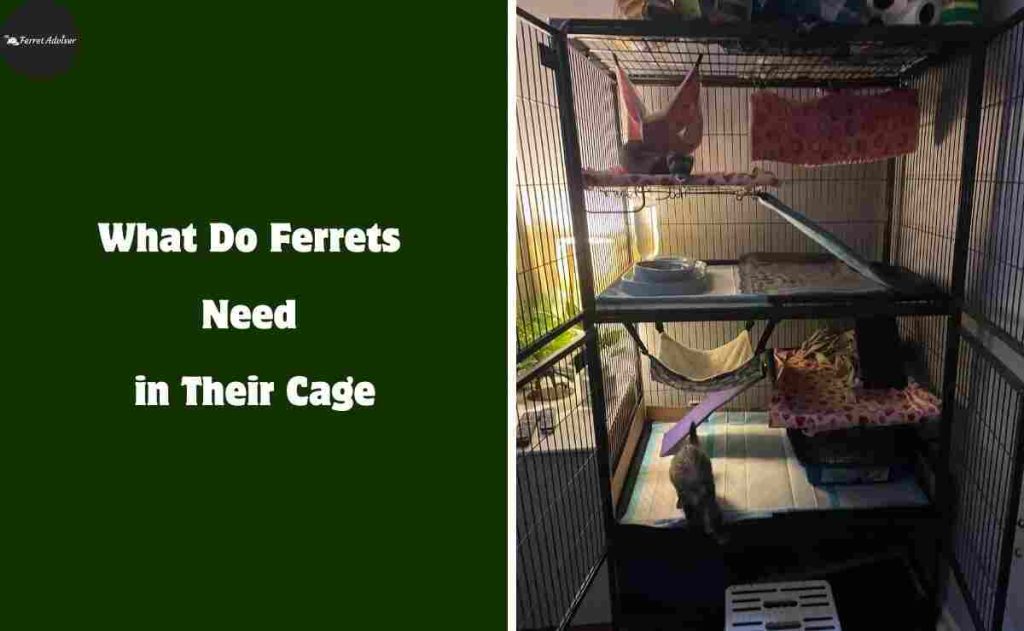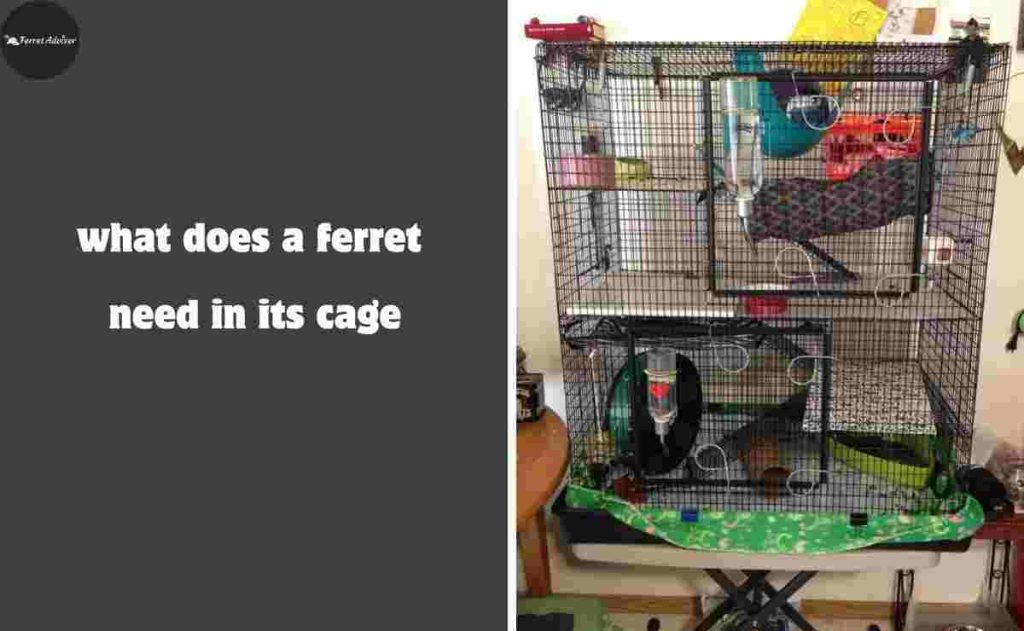What Do Ferrets Need in Their Cage? Ferrets are playful, curious creatures that require a well-structured environment to grow well. Since they spend a significant amount of time in their cages, it’s crucial to ensure that their living space is safe, comfortable, and stimulating.
While setting up a ferret’s cage might seem straightforward, there are specific needs and considerations that often go overlooked. This guide will cover everything you need to know to create the perfect ferret cage, addressing gaps in common advice and providing a comprehensive, enriched approach.
Why Is Proper Cage Organization Important?
A well organized ferret cage isn’t just about neatness, it plays a vital role in your ferret’s health, hygiene, and happiness. Here’s why proper organization matters:
- Health and Safety: Ensuring each part of the cage is designated for specific activities (eating, sleeping, playing, and using the litter box) helps maintain a clean environment, minimizing the risk of bacterial infections and illnesses.
- Stimulation: A well-planned cage provides ferrets with mental and physical stimulation. The right toys, bedding, and accessories make their cage an engaging space that mimics their natural behaviors.
- Hygiene: Separating food, water, and litter areas ensures that waste doesn’t contaminate where they eat and drink, promoting overall cleanliness and reducing odor.
- Convenience: A well-arranged cage makes cleaning and maintaining it easier. When everything has its place, you’ll spend less time rearranging accessories and more time interacting with your pet.
Now, let’s dive deeper into the essential elements of setting up the ultimate ferret cage.
What Do Ferrets Need in Their Cage

Ferrets usually stay most of the time in their cage. So, the the cage should be well structured and have comfortable environment for their living. Following things should be taken care in relation to Ferret cage.
1. Choosing the Right Cage: Size, Structure and Safety
One of the most crucial steps in creating an ideal habitat for your ferret is choosing the right cage. While many resources briefly touch on this, there are key details to consider to ensure long-term comfort and safety.
Cage Size and Structure
- Space Requirements: A ferret needs plenty of room to explore, climb, and burrow. At a minimum, a single ferret should have a cage that’s at least 24” x 24” x 18”, but bigger is always better. A multi-level cage is highly recommended to provide vertical space for climbing, something that ferrets enjoy.
- Bar Spacing: Ensure that the cage bars have a spacing of 1 inch (2.5 cm) or less. Ferrets are escape artists, and any larger gaps could allow them to squeeze through.
- Solid Floors: Wire floors can hurt a ferret’s paws and cause a painful condition called Bumblefoot. Make sure the platforms are solid or covered with appropriate liners.
Ventilation and Accessibility
Ferrets are sensitive to poor ventilation, so avoid cages with enclosed or plastic sides that restrict airflow. The cage should also have multiple doors that provide easy access for cleaning and interacting with your ferret.
Safe Materials
Choose a cage made of non-toxic, durable materials like powder-coated metal. This ensures the cage won’t rust or deteriorate over time, and it’s safe for your ferret to explore and chew on without risking harm.
2. Essential Cage Accessories: What Every Ferret Cage Needs
After choosing the perfect cage, it’s time to fill it with the necessary accessories. Ferrets require more than just food and water; they need specific items to keep them healthy, happy, and entertained.
Food and Water Bowls
- Tip-Proof Bowls: Ferrets love to push, flip, and spill things. To prevent constant messes, use tip-proof, attachable ceramic or stainless-steel bowls that can be securely fastened to the sides of the cage.
- Hydration Options: Ferrets drink a lot of water, so a water bottle with a spout or heavy water dish (attached to the cage) is essential to prevent spillage. Ensure the water is changed daily to stay fresh and clean.
Litter Box and Litter
- Litter Box Placement: Place the litter box in a corner on the lowest level of the cage. This not only makes it easier to clean but also helps ferrets naturally gravitate toward using it. Opt for a corner litter box with a locking mechanism to prevent your ferret from moving it around.
- Litter Type: Use paper-based or pellet litter, which is dust-free and safe for ferrets. Avoid using cat litters (especially clumping types) as they can be harmful if ingested or inhaled.
Bedding and Liners
- Fleece Bedding: Ferrets prefer soft, washable materials like fleece blankets or old t-shirts. Avoid using wood shavings, especially cedar or pine, as the oils can harm their respiratory system.
- Liners: If your cage has wire floors or ramps, use thick fleece liners or cut-to-fit plastic boards to protect your ferret’s paws. Liners also make cleaning much easier since you can remove them for washing.
3. Creating Zones in the Ferret Cage: Organization for Comfort and Hygiene

A well-organized ferret cage is divided into specific zones for different activities: sleeping, eating, bathroom, and play. This helps your ferret understand where to perform each activity, keeps the cage cleaner, and reduces stress on your pet.
Ferrets are naturally clean animals, and they prefer not to mix their sleeping, eating, and bathroom areas. By clearly dividing these zones in their cage, you promote a healthier environment and help prevent contamination.
Sleeping Area: Cozy and Comfortable
Ferrets sleep for 14–18 hours a day, so providing a comfortable sleeping area is critical to their well-being.
- Hammocks: Ferrets love to sleep in elevated, cozy hammocks. Place hammocks on higher levels of the cage, away from the litter box. You can add multiple hammocks to give them variety, and having different heights helps mimic their natural instincts to climb and burrow.
- Blankets and Hideaways: Along with hammocks, provide fleece blankets, soft tunnels, or hideaway cubes. Ferrets enjoy burrowing and curling up in dark, enclosed spaces, which makes them feel safe and secure.
Eating Area: Clean and Secure
Your ferret’s food and water should be kept far away from the litter box to prevent contamination.
- Placement: Place the food and water bowls on a higher platform to avoid litter particles from being tracked into their food. This keeps the eating area more hygienic.
- Attachable Bowls: As mentioned earlier, ferrets love to push and flip bowls, so using attachable, tip-proof bowls ensures they stay put and prevent spills.
Bathroom Area: Litter Box Setup
The bathroom area should be on the lowest level of the cage, in a corner. This is the most natural and convenient spot for your ferret to use the litter box, and it makes cleaning easier for you.
- Litter Box Tips: Use a corner-shaped litter box with a secure locking mechanism so your ferret can’t move it around. Check the box frequently and clean it daily to maintain hygiene.
- Accident Prevention: Ferrets sometimes have accidents outside the litter box. To minimize this, place pee pads or small washable mats around the bathroom area to catch any spills.
Play Area: Entertainment and Stimulation
Ferrets are energetic and intelligent creatures that need plenty of mental and physical stimulation. Incorporating a dedicated play area with toys in their cage is essential for keeping them happy and engaged.
- Toys: Include safe, chew-proof toys like hard plastic balls, tunnels, or interactive puzzle toys. Avoid toys with small parts that can be swallowed.
- Rotate Toys: Ferrets can get bored with the same toys. Rotate their toys every few weeks to keep things exciting and prevent boredom.
- Tunnels: Ferrets love running through tunnels, so consider adding a flexible ferret tunnel inside the cage. This adds both mental stimulation and physical exercise, mimicking their natural burrowing instincts.
4. Enhancing the Cage Environment: Enrichment and Comfort
Ferrets are highly intelligent animals that require more than just the basics to stay content. To ensure they remain physically and mentally stimulated, you need to enrich their cage environment with features that support their natural instincts, such as burrowing, climbing, and exploring.
Enrichment Features for Your Ferret’s Cage
Enrichment not only keeps your ferret happy, but it also helps prevent boredom, which can lead to destructive behavior. Here are some ideas for enriching their environment:
- Climbing Platforms: Multi-level cages with ramps and platforms allow ferrets to climb, jump, and explore. Create different heights and angles to encourage climbing and exercise.
- Digging Box: If you have space, a small digging box filled with non-toxic materials like shredded paper or cloth strips can provide a safe and engaging digging experience for your ferret.
Adding Variety to the Cage
Variety is key to keeping your ferret engaged. A good practice is to rotate toys and rearrange the layout of their cage occasionally. Moving hammocks, hiding toys in new places, or adding new tunnels will stimulate their curiosity and make their environment feel fresh.
5. Safety Measures: Ferret-Proofing the Cage
While ferrets are playful and adventurous, they’re also prone to accidents. To keep your ferret safe, it’s essential to ferret-proof the cage and its accessories.
Avoiding Choking Hazards
- Toy Safety: Only provide toys that are specifically made for ferrets or are known to be safe for small animals. Avoid toys with small detachable parts, buttons, or beads, as ferrets can easily swallow these and choke.
- Bedding Safety: Use soft materials like fleece for bedding, as loose fibers from blankets or towels can sometimes get caught around a ferret’s toes or neck. Always check blankets for loose threads.
Preventing Cage Injuries
- Cover Wire Floors and Ramps: Wire floors and ramps can cause injuries like Bumblefoot (an infection of the feet). Always cover these areas with soft, thick liners or use platforms with solid surfaces.
- Secure Accessories: Ferrets love to push, pull, and knock things over. Ensure all accessories, like food and water bowls, are securely fastened to the sides of the cage to prevent them from being tipped over or becoming a hazard.
Temperature and Lighting Considerations
- Temperature Control: Ferrets are sensitive to extreme temperatures. Keep their cage in a room with a stable temperature, ideally between 60°F and 75°F (15°C to 24°C). Avoid placing the cage near direct sunlight or drafts.
- Lighting: Ferrets need a consistent day-night cycle to regulate their sleep patterns. While they enjoy a cozy, dark sleeping space, ensure they’re exposed to natural daylight or consistent indoor lighting during the day. Avoid leaving them in artificial light for extended periods, as this can interfere with their biological clock.
6. Cage Maintenance and Cleaning: Ensuring a Hygienic Environment
Keeping your ferret’s cage clean is crucial to maintaining their health and preventing bad odors. Regular maintenance not only ensures a fresh living environment but also reduces the risk of illnesses, such as respiratory infections or bacterial growth.
Daily Cleaning Routine
- Litter Box: Clean the litter box daily. This prevents unpleasant smells and reduces the risk of bacteria buildup. Replace the litter completely every 2–3 days, depending on usage.
- Food and Water Bowls: Change water daily and clean both the food and water bowls with warm, soapy water. Make sure they are thoroughly rinsed to avoid any harmful residue.
- Spot-Clean: Wipe down areas where food crumbs or litter debris have accumulated. This keeps the cage looking tidy and minimizes the need for deep cleaning.
Weekly and Monthly Deep Cleaning
- Deep Clean the Cage: Once a week, remove all accessories (hammocks, toys, ramps, etc.), and scrub the cage with a pet-safe disinfectant. Make sure to thoroughly rinse and dry the cage to prevent any cleaning chemicals from lingering.
- Wash Bedding and Hammocks: Launder all washable items, such as blankets and hammocks, at least once a week to eliminate dirt and oils. Use a mild, unscented detergent to avoid irritating your ferret’s sensitive nose.
- Inspect Toys and Accessories: As part of your weekly routine, check all toys, tunnels, and accessories for wear and tear. Replace any broken items or those with loose parts that may become hazardous.
Tips for Optimal Ferret Cage Setup
Now that you have a comprehensive understanding of what your ferret needs in their cage, here are some final tips to ensure you provide the best possible care:
- Rotate Playtime: While it’s important to keep the cage stimulating, ferrets also need out-of-cage time. Aim for at least 4 hours of supervised free-roaming time per day. This helps them burn off energy and reduces stress from being confined.
- Regular Health Checks: When cleaning the cage, take the opportunity to do a quick health check on your ferret. Look for any signs of illness, such as unusual lethargy, changes in appetite, or difficulty breathing.
- Bonding Through Cage Time: Spend time interacting with your ferret inside their cage during cleaning or enrichment setups. This helps build trust and makes your ferret more comfortable with cage changes.
Conclusion
Setting up a ferret cage properly requires attention to their unique needs for space, safety, and stimulation. By creating designated zones for sleeping, eating, bathroom, and play, and incorporating enriching features, you provide a healthy and comfortable environment for Ferret.
Regular maintenance and safety precautions will keep the cage a safe and hygienic space for your ferret to thrive.
With the right setup and care, your ferret’s cage can become a place where they feel secure, entertained, and well-cared for. Remember that ferrets, while independent, rely on you to create a living space that suits their active and curious nature.
